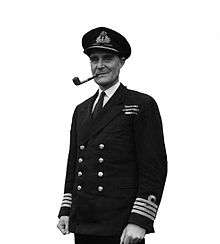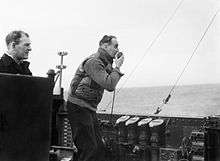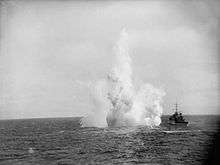Frederic John Walker
- For the English cricketer, see Frederic Walker.
| Frederic John Walker | |
|---|---|
 | |
| Born |
3 June 1896 Plymouth, England |
| Died |
9 July 1944 (aged 48) Seaforth, Merseyside, England |
| Allegiance |
|
| Service/branch |
|
| Years of service | 1914–1944 |
| Rank | Captain |
| Battles/wars | |
| Awards |
Companion of the Order of the Bath Distinguished Service Order & Three Bars Mentioned in Despatches |
Captain Frederic John Walker CB, DSO & Three Bars (3 June 1896 – 9 July 1944) (his first name is given as Frederick in the Oxford Dictionary of National Biography[1] and some London Gazette entries) was a Royal Navy officer noted for his exploits during World War II. Walker was the most successful anti-submarine warfare commander during the Battle of the Atlantic and was known more popularly as Johnnie Walker (after the whisky).
Early life and career
Walker was born in Plymouth, the son of Frederic Murray and Lucy Selina (née Scriven) Walker. He joined the Royal Navy as a cadet in 1909 and was educated at the Royal Naval Colleges at Osborne and Dartmouth, where he excelled. First serving on the battleship Ajax as a midshipman, Walker as a sub-lieutenant went on to join the destroyers Mermaid and Sarpedon in 1916 and 1917 respectively. Following the end of the First World War, Walker joined the Queen Elizabeth-class battleship Valiant. He married Jessica Eileen Ryder Stobart, with whom he had three sons and a daughter.[1]
Interwar Period, 1920s–1930s
During the inter-war period Walker partook in the particularly unglamorous unfashionable field of anti-submarine warfare. He took a course at the newly founded anti-submarine training school of HMS Osprey, Portland which was established in 1924. Walker consequently became an expert in this particular type of warfare, and was appointed to a post specialising in this field, serving on a number of capital ships. In May 1933 he was promoted to commander and took charge of the First World War destroyer Shikari. In December 1933 Walker took command of the Shoreham-class sloop Falmouth based on the China Station. In April 1937 Walker became the Experimental Commander at HMS Osprey.
World War II
When the Second World War began, in 1939, Walker's career seemed at an end. Still a Commander, he had been ignored for promotion to captain and indeed had been scheduled for early retirement. He gained a reprieve, however, due to the commencement of war and in 1940 was appointed as Operations Staff Officer to Vice-Admiral Sir Bertram Ramsay. Even so, Walker still had not been given a command, despite expertise in anti-submarine warfare that would no doubt be indispensable in the Battle of the Atlantic. During Walker's time in that role the legendary Dunkirk evacuations took place, in which the British Expeditionary Force (BEF) was evacuated from France. The evacuation was an immense success, with over 330,000 British and French troops being taken to the United Kingdom. He was Mentioned in Despatches for his work during the evacuation.[2]
Walker finally received a command in October 1941, taking control of the 36th Escort Group, commanding from the Bittern-class sloop Stork. The escort group comprised two sloops (including Stork) and six corvettes and was based in Liverpool, home of Western Approaches Command. Initially his Group was primarily used to escort convoys to and from Gibraltar.
His first chance to test his innovative methods against the U-boat menace came in December when his group escorted Convoy HG 76 (32 ships). During the journey five U-boats were sunk, four by Walker's group, including U-574 which was depth-charged and rammed by Walker's own ship on 19 December. The RN's loss during the Battle for HG76 was one escort carrier (Audacity), one destroyer (Stanley) and two merchant ships. This is sometimes described as the first true Allied convoy victory in the Battle of the Atlantic. He was given the Distinguished Service Order (DSO) on 6 January 1942 for, "For daring, skill and determination while escorting to this country a valuable Convoy in the face of relentless attacks from the Enemy, during which three of their Submarines were sunk and two aircraft destroyed by our forces".[3] Walker's group succeeded in sinking at least three more U-boats during his tenure as commander of the 36th Group. He was awarded the first Bar to his DSO in July 1942.[4]
In 1942 Walker left the 36th Group and became Captain (D) Liverpool, granting him some time to recuperate. He finally returned to a ship command when he became commander of the 2nd Support Group in 1943, consisting of six sloops. Walker led from Starling, a newly commissioned Black Swan-class sloop. The group was intended to act as reinforcement to convoys under attack, with the capacity to actively hunt and destroy U-boats, rather than be restricted to escorting convoys. Walker had suggested the innovative idea to Commander-in-Chief Western Approaches Command Sir Max Horton. The combination of an active hunting group and a charismatic, determined and innovative anti-submarine specialist such as Walker proved to be a potent force. One eccentric aspect of his charismatic nature was the playing of the tune A Hunting We Will Go over the ship's Tannoy when returning to their base.
In June 1943 Walker's own ship Starling was responsible for the sinking of two U-boats. The first, U-202, was destroyed on 2 June by depth charges and gunfire, and the other, U-119, on 24 June by depth charges and ramming. Another U-boat, U-449, was sunk by his group on the same day. One highly successful tactic employed by Walker was the creeping attack, where two ships would work together to keep contact with a U –boat whilst attacking; a refinement of this was the barrage attack, which had three or more sloops in line to launch depth charges to saturate the area with depth charges in a manner similar to a rolling barrage by artillery in advance of an infantry attack. On 30 July Walker's group encountered a group of three U-boats on the surface (two were vital type XIV replenishment boats known as "Milk Cows") while in the Bay of Biscay. He signalled the "general chase" to his group and fired at them, causing damage that prevented them from diving. Two of the submarines, U-462, a Type XIV, and U-504, a Type IX/C40, were then sunk by Walker's group, and the second Type XIV, U-461, by an Australian Short Sunderland flying boat.

Upon his return to Liverpool, Walker was informed that his son, Timothy, had been killed when the submarine HMS Parthian had been lost in early August 1943 in the Mediterranean. On 14 September 1943 he was appointed a Companion of the Bath (CB), "for leadership and daring in command of H.M.S. Starling in successful actions against Enemy submarines in the Atlantic."[5]

On 6 November 1943 Walker's group sank U-226 and U-842. In early 1944 Walker's group displayed their efficiency against U-boats by sinking six in one patrol. On 31 January 1944 Walker's group gained their first kill of the year when they sank U-592. On 9 February his group sank U-762, U-238, and U-734 in one action, then sank U-424 on 11 February, and U-264 on 19 February. On 20 February 1944 one of Walker's group, HMS Woodpecker, was torpedoed and sank seven days later while being towed home; all of her crew were saved. They returned to their base at Liverpool to the thrilled jubilation of the city's inhabitants and the Admiralty. The First Lord of the Admiralty was present to greet Walker and his ships. Walker was promoted to captain and awarded a second bar to his DSO.[6]
In March Walker's group provided the escort for the American cruiser USS Milwaukee which was on its way to Russia as part of the lend-lease programme. Walker's group sank two U-boats on the outward trip and a third on the return trip. Walker's last duty was protecting the fleet from U-boats during D-Day, the immense Allied invasion of France. This he did successfully for two weeks; no U-boats managed to get past Walker and his vessels, and many were sunk or damaged in the process. During this concerted effort Walker's dedication to his tasks was tremendous; he took no respite from his duties, which ultimately contributed to his death. He was awarded the third bar to his DSO on 13 June 1944,[7] and was again Mentioned in Despatches on 20 June 1944.[8]
Death
Walker suffered a cerebral thrombosis on 7 July 1944 and died two days later at the Naval Hospital at Seaforth, Merseyside aged 48; his death was attributed to overwork and exhaustion.
His funeral service took place at the Liverpool Anglican Cathedral with full naval honours and attended by about 1,000 people. The scene was emotional as the naval procession followed, travelling through the streets of Liverpool to the docks where he embarked aboard destroyer Hesperus for his final journey to be buried at sea.[9] A further honour was a Mention in Despatches on 1 August 1944.[10] As Walker's Group had already sailed, the sailors who undertook the procession and funeral and burial at sea were mostly Canadian.
Legacy
Walker sank more U-boats during the Battle of the Atlantic than any other British or Allied commander and was instrumental in the Allied victory of the Battle of the Atlantic, one of the most important campaigns of the war. In 1998 a statue by Liverpool sculptor Tom Murphy of Captain Johnnie Walker in a typical pose was unveiled at the Pier Head in Liverpool by HRH the Duke of Edinburgh. The campaign for the statue had been launched by the Captain Walker's Old Boys Association. Members of the Association met in Liverpool during the 60th Anniversary of the victory of the Battle of the Atlantic in 2003 to commemorate their comrades.
Johnnie Walker's grandson, Patrick Walker, continues the Walker association with the Royal Navy(now retired). He is also a submariner and has achieved the rank of captain of the First Submarine Squadron. He is also President of the Captain Walker's Old Boys Association dedicated to Captain Walker and the men who served with him. The Association disbanded in 2004 as many of the members were now too old to attend. The Standard is now on display in Bootle Town Hall along with many memorabilia of Walkers ships. Starling's bell is rung to commence each Council Meeting. Walker was to be promoted to Admiral, given a Fleet and sent to the Pacific.
Honours and awards
- 16 August 1940 – Mentioned in Despatches – Commander Frederic John Walker Royal Navy.
- 6 January 1942 [11] – To be a Companion of the Distinguished Service Order – Commander Frederic John Walker, Royal Navy, HMS Stork:
For daring, skill and determination while escorting to this country a valuable Convoy in the face of relentless attacks from the enemy, during which three of their Submarines were sunk and two aircraft destroyed by our forces.— London Gazette
- 30 July 1942[12] – Bar to the Distinguished Service Order: To Captain Frederic John Walker DSO, Royal Navy:
For leadership and skill in action against enemy submarines while serving in H.M. Ships Stork and Vetch. Second DSO awarded as a bar for on the ribbon of the first DSO.— London Gazette
- 14 September 1943 – Companion of the Order of the Bath to Captain Frederic John Walker DSO, Royal Navy:
For leadership and daring in command of H.M.S. Starling in successful actions against enemy submarines in the Atlantic.— London Gazette
- 22 February 1944[13] Second Bar to the Distinguished Service Order – Captain Frederic John Walker CB, DSO, Royal Navy:
For gallant and distinguished services in the destruction of two U-boats while serving in H.M. Ships Starling, Kite, Wildgoose and Woodcock, patrolling in the North Atlantic.— London Gazette
- 13 June 1944[14] – Third Bar to the Distinguished Service Order – Captain Frederic John Walker CB, DSO, Royal Navy:
For outstanding leadership, skill and determination in H.M. ships Starling, Wild Goose, Kite, Woodpecker and Magpie in the destruction of six U-boats in the course of operations covering the passage of convoys in the North Atlantic.— London Gazette
- 20 June 1944 [15]- Mentioned in Despatches – Captain Frederic John Walker CB, DSO Royal Navy.
For outstanding leadership, skill and devotion to duty in H.M. ships Starling, Wild Goose and Wanderer on convoy escort duty in the North Atlantic.— London Gazette
- 14 August 1944 – Mentioned in Despatches – Captain Frederic John Walker CB, DSO Royal Navy.
References
- 1 2 Sainsbury, A. B. (September 2004). "'Walker, Frederick John (1896–1944)'". Oxford Dictionary of National Biography. Oxford University Press. doi:10.1093/ref:odnb/36690. Retrieved 2008-01-24. (subscription required (help)).
- ↑ The London Gazette: no. 34925. pp. 5063–5068. 16 August 1940. Retrieved 2008-01-24.
- ↑ The London Gazette: (Supplement) no. 35407. p. 135. 2 January 1942. Retrieved 2008-01-24.
- ↑ The London Gazette: no. 35648. p. 3346. 28 July 1942. Retrieved 2008-01-24.
- ↑ The London Gazette: (Supplement) no. 36169. p. 4073. 10 September 1943. Retrieved 2008-01-24.
- ↑ The London Gazette: (Supplement) no. 36390. p. 902. 10 September 1943. Retrieved 2008-01-24.
- ↑ The London Gazette: (Supplement) no. 36561. p. 2817. 9 June 1944. Retrieved 2008-01-24.
- ↑ The London Gazette: (Supplement) no. 36572. p. 2932. 16 June 1944. Retrieved 2008-01-24.
- ↑ Macintyre, Donald (1976 (1st ed 1956)). U-Boat Killer. Annapolis, Maryland: Naval Institute Press (1st American ed). p. 148. ISBN 0-87021-964-2. Check date values in:
|date=(help) - ↑ The London Gazette: no. 36634. p. 3568. 28 July 1944. Retrieved 2008-01-24.
- ↑ London Gazette 6 January 1942
- ↑ London Gazette 30 July 1942
- ↑ London Gazette 22 February 1944
- ↑ London Gazette 13 June 1944
- ↑ London Gazette 20 June 1944
- Robertson, Terence (1956). Walker, RN. London: Evans Brothers Limited.
- Dan van der Vat: The Atlantic Campaign (1988). ISBN 0-340-37751-8
- Paul Kemp: U-Boats Destroyed ( 1997). ISBN 1-85409-515-3
External links
| Wikimedia Commons has media related to Frederic Walker. |
- Walker, RN, BBC People's War
- Short biographies of Royal Navy (RN) Officers, 1939–1945
- Captain Walker RN
